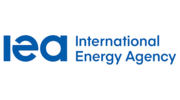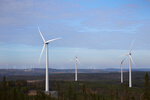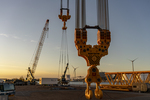News Release from International Energy Agency (IEA)
Wind Industry Profile of
New IEA report lays out recommendations to speed up technology development and overcome high costs of drastically reducing emissions from steel and cement production
The report, Achieving Net Zero Heavy Industry Sectors in G7 Members, was requested by Germany under its 2022 Presidency of the G7 to inform policy makers, industrial leaders and other decision makers ahead of this month’s G7 Climate, Energy and Environment Ministers’ Meeting in Berlin and beyond. The report lays out a series of recommendations for G7 economies to advance the transition towards near zero emission steel and cement production, building on the IEA’s landmark report last year, Net Zero by 2050: A Roadmap for the Global Energy Sector.
G7 members – Canada, France, Germany, Italy, Japan, the United Kingdom, the United States plus the European Union – account for around 40% of the global economy, 30% of energy demand and 25% of energy system CO2 emissions. Meanwhile, heavy industry’s direct CO2 emissions amount to around 6 billion tonnes per year, more than one-sixth of total CO2 emissions from the global energy system. Producers of steel and cement in particular face unique challenges to drastically reduce their emissions footprint. The G7’s economic heft, technology leadership and international alliances present it with a special role in leading the way and inspiring successful energy transitions in these crucial sectors, the new report says.
“There is no way to reach net zero without dramatic reductions in emissions from heavy industry, and G7 economies have both a responsibility and an opportunity to take a leadership role in driving that forward,” said IEA Executive Director Fatih Birol. “Emissions from heavy industry are among the most stubborn, making it essential that countries with significant financial and technological resources use them to scale up practical solutions in a coordinated way. This new report sets out realistic and actionable steps for G7 members that can provide a catalyst for the global progress that is urgently needed.”
“To achieve our goal to limit the global temperature rise to 1.5 degrees, we have to decarbonise our industries. This decade is key to set the tracks to climate neutrality. Especially in sectors where emissions are high but hard-to-abate like steel and cement, we have to fundamentally shift production methods,” said Robert Habeck, Germany’s Federal Minister for Economic Affairs and Climate Action. “The IEA report Achieving Net Zero Heavy Industry Sectors in G7 Members shows us pathways and advances our understanding of the tools and definitions we need. It brings us a big step further to jointly create an international economic and political environment that incentivises investments in green and low carbon production facilities. We want the G7 to be a pioneer in this process.”
Heavy industry is responsible for more than 15% of coal use and about 10% of oil and gas use in G7 members. This makes the net zero transition in heavy industry an important pillar for reducing the reliance on fossil fuels in the G7 in the wake of Russia’s invasion of Ukraine. However, many of the technologies for significantly reducing emissions from heavy industry are still at large prototype or demonstration stage, and competitive international markets for heavy industrial products often result in profit margins that are too thin to cover the higher up-front costs of integrating low emission processes.
The new IEA report sets out a toolbox that G7 members can draw upon and recommends that they set out ambitious long-term energy transition targets for heavy industry while supporting demonstration and early commercial projects through targeted finance and other risks mitigation measures. These supply-side efforts would also leverage essential private investment, it says.
On the demand side, the report recommends using carbon contracts for difference, public procurement rules, mandates, quotas and other related measures to create differentiated markets for steel and cement production with near zero emissions, which at least in the immediate future will be more expensive than materials made using legacy processes.
Importantly, the report also calls for G7 governments to adopt stable, absolute and ambitious thresholds for material production with near zero emissions. It proposes definitions and relevant thresholds for the G7 to adopt as a starting point that are compatible with a global pathway to net zero emissions by 2050.
G7 members should work with industry to establish agreed-upon thresholds, definitions and measurement standards for what constitutes steel and cement production with near zero emissions, according to the report. This is essential for establishing policy and production guidelines. Given the urgency of the transition, the report says that G7 economies need to set mechanisms to recognise the use of interim technologies that substantially reduce emissions but do not go far enough to be considered near zero emissions.
- Source:
- IEA
- Author:
- Press Office
- Link:
- www.iea.org/...
- Keywords:
- G7, IEA, development, technology, innovation, emissions, steel, cement, production, renewable energy, hydrogen, report, energy demand



























